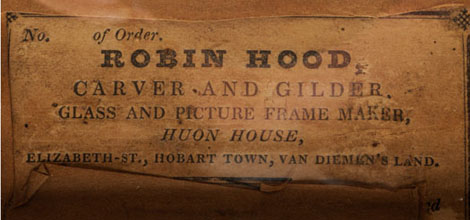Trophy flag
Trophy flag
1841
Lady Jane Franklin (1791–1875) and others
textile (silk cloth and thread); wood (unidentified pine)
39.4 w x 45.8 h cm (visible)
S393
Provenance
This flag was accessioned into the Tasmanian Museum and Art Gallery collection in 1946, and is on loan from the Governor of Tasmania.
History
This flag, along with a five-oared gig valued at forty pounds, was a race prize at the fourth Hobart Town Regatta, held in 1841. It was provided by Lady Jane Franklin (1791–1875), the wife of the Lieutenant-Governor of the colony, Sir John Franklin (1786–1847). The embroidered Latin motto belongs to the Franklin family and can be loosely translated as ‘we strive’ or ‘we endeavour’.
During their brief stay in Tasmania, the Franklins sought to encourage the development of both the arts and industry in the colony. Lieutenant-Governor Franklin established the Regatta in 1838 to celebrate the European discovery of the island by the Dutch explorer Abel Tasman, and to acknowledge the importance of the River Derwent and the Port of Hobart to the island’s life and economy. The presentation of this flag, along with a fine, colonial-built gig was to encourage local boat building and reward prowess on the water, though the race was run strictly for ‘gentlemen amateurs’.
A notice in the Hobart Town Advertiser, 5 November 1841 advised:
Fourth Anniversary Regatta.
Under the patronage of his Excellency
Sir John Franklin, K.C.H.
Committee
C. McLachlan T Hewitt
M Forster E Abbott
W Moriarty J Spode
J.M. Wilson J Kelly
George Bagot
…………..
Lady Franklin’s Prize,
FOR AMATEURS
A Five – oared gig, value £40
Presented by Lady Franklin, which has been
built for this occasion.
This prize is to be contended for by Gigs of
Colonial build, or by boats imported expressively for
the Regatta. The names of the Crews are
requested to be given in at the Port Office for
approval by the Committee. Six boats, or no
race.
According to a contemporary newspaper report the flag was presented along with a small British ensign, both embroidered by ‘… the ladies of His Excellency’s family’. As the Franklins had no children it is not known who the embroiderers were. One possibility is that Lady Franklin’s companion and Sir John Franklin’s niece, Sophia Cracroft (1816–92) worked on the flag.
Description
Part of a white silk flag or pennant stretched over a rectangular wooden strainer
frame. The face side is plain, fine-weave silk embroidered with a design consisting of an appliqué garter or belt in blue fabric framing embroidered sprigs of flowering wattle. The garter has an embroidered edge of gold satin stitch and is represented as looped and buckled at the lower centre. It frames the sprigs of wattle branches, leaves and flowers, which are embroidered in satin stitch in various shades of green. Within the garter band at the top, the letters ‘NISU’ are rendered in appliqué metallic thread. The white silk has a horizontal join through the centre, indicating that the object was trimmed from a larger piece of fabric, probably a flag. In the upper part of the reserve, created by the garter band, is an embroidered inscription in black thread.
Statement of Significance
The Tasmanian Museum and Art Gallery seeks to build a comprehensive representation of Tasmanian colonial decorative arts. This includes items made in Tasmania from 1803 to 1901. The NISU flag is a rare surviving presentation textile. It points to the importance placed by Tasmanian colonists and the colonial administration on the encouragement of maritime achievement in Tasmania. Dated 1841, this flag is also one of the earliest examples of the use of native plants in Australian textiles. The use of the wattle motif points to the colonist’s willingness to embrace the local environment and attribute symbolic significance to it.
Inscriptions
Embroidered inscription in black thread on face reads: ‘This flag presented by Lady Franklin with a prize boat, won / by the gig Centipede built by Messrs Risbys 1841’.
Printed paper label adhered to reverse of stretcher reads: ‘No. of order. / ROBIN HOOD / CARVER AND GILDER / GLASS AND PICTURE FRAME MAKER, / HUON HOUSE / ELIZABETH STREET, HOBART TOWN, VAN DIEMEN’S LAND’.

© 2009 Tasmanian Museum and Art Gallery
This page was last modified on :
1 July, 2010

